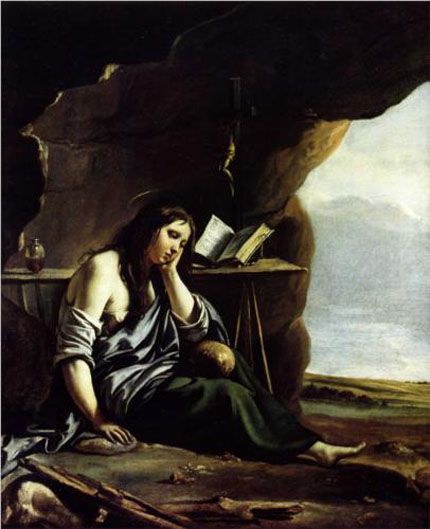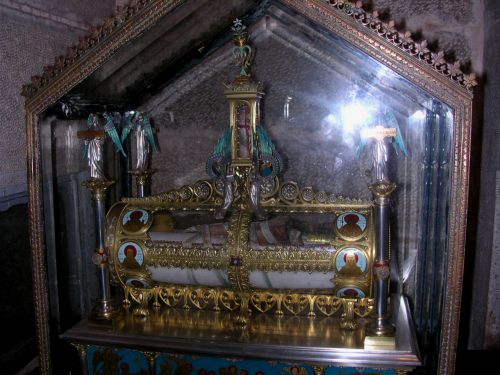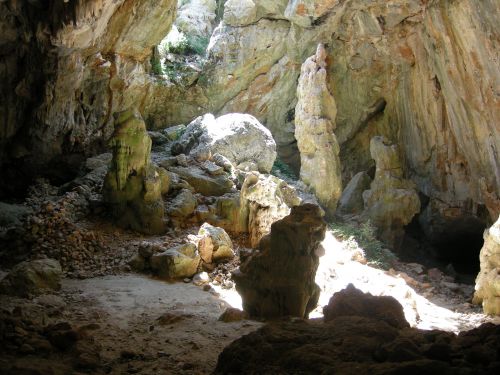Mary Magdalene in Caves?
Throughout the last 1,500 years of history Christianity has had the idea that Mary Magdalene was a wicked women who spent her life after the crucifixion repenting for her sexual sins in a cave, all alone and crying, with her clothes dropping off in rags, throughout the heat of summer and the freezing cold of winter. So many religious paintings show this scene.


And so many give the impression the artist was delighted by the chance to paint a sensuous half-naked woman who, incidentally, never grew old through the thirty years she lived in such destitution. Many of them show her completely naked or else partially covered, by long hair. She is sublimely sexual, voluptuous, but with tears running down her face in her thirty year distress because she had sinned.
We sense their deepest thoughts are; she deserved it because she was sexual.
 One picture I found even showed her with her legs apart and bare and her skirt pulled up.
One picture I found even showed her with her legs apart and bare and her skirt pulled up.
From the sixth century Mary Magdalene was considered to be a sinner by Pope Gregory; he was going on the theory that the seven devils that were chased out of her by Jesus were the seven deadly sins. He did not know that the expression “devils” was used at the time to mean illness; simply, Jesus had cured Mary.
The Roman church eventually agreed that the concept of Mary as a sinner perpetually repenting her sins was faulty. An apology for all the insults to Mary over the centuries was written, and Mary Magdalene was canonised in the year 1969. But people still go on about her as a reformed prostitute. How on earth could this apply to the wealthy lady from Magdala who supported Jesus “of her own substance”? She was not a poor woman. Her father, Simon the Pharisee was a High Priest, one of the leaders of Jerusalem, and her mother, who died before Mary met Jesus, was reputed to be a princess. This may have been why Mary’s daughter was called “Sara” which means princess.
So how did the “prostitute” label come about? It’s because for hundreds of years Mary Magdalene, especially in Provence, was confused with another Mary, called Mary the Egyptian. I looked up the two in my French book of saints.
It told me; Around 500AD Mary the Egyptian left her home at the age of twelve years and worked several years in Alexandria as a “public girl.” Approaching thirty years old, moved by curiosity, she joined a caravan of pilgrims going to Jerusalem. There, a mysterious force manifested itself at Saint-Sépulchre church, it affected other pilgrims too, and Mary the Egyptian was inspired to leave the world, to live in solitude in the desert, to atone for her sins.
She bought three loaves which miraculously kept renewing themselves, and lived on them, with dates and berries, for many long years. Her clothes wore out and so she lived naked but covered by her long hair. Through all the long years of solitude, she was visited only by Zosime who, at her request, carried her to the banks of the river Jordan, near the place where Jesus was baptised. Later he found Mary the Egyptian dead, and buried her with the help of a lion.
Mary the Egyptian is the patron saint of penitents; she is linked with Mary Magdalene, and the diffusion of her cult in the Middle Ages was often alongside that of Mary Magdalene.


The first picture, and its confusion, clearly demonstrates my point. In the second, even Titian is confused.
Mary the Egyptian is pictured living in a cave, a wild creature but praying, naked but for her hair. Mary Magdalene, in my saints book, is pictured with long hair sometimes braided, dressed in the latest fashions in elaborate and expensive clothes, often disordered, carrying a jar of ointment. She protects gardeners, hairdressers, perfumiers and glove-makers. Her cult diffused itself around Europe from Provence, where it is believed she was buried.
Provence, not Languedoc? Ah, in Roman times ALL the south of France was called Provence, from the Latin word for “province.”
It is clear what happened in the early Middle Ages. Mary the Egyptian and Mary Magdalene were confused and merged into one, especially by those who could not read or write, which included the vast bulk of the population except for the clergy. Mary Magdalene never lived long years in a cave - that was Mary the Egyptian.
For some reason Mary the Egyptian was much loved by the Compostella Pilgrims who carried cockleshells; it was the emblem of St James who had arrived at the mouth of the river near Compostella where cockles were collected. This emblem became connected with Mary the Egyptian and then with Venus, the goddess of beauty connected mythologically with both the Mary's. Which is why Botticelli's Birth of Venus shows standing on a cockleshell when she is blown to shore.
Ste Baume
The cave of Ste Baume is about 22km south of St. Maximim-la-Ste-Baume in Provence. It is a favourite pilgrimage and spiritual tourism spot for both Roman Catholics and spiritual searchers looking for Mary Magdalene. There’s a steep walk up to it and the cave, now converted to a church, looks out over a fantastic view. Inside the church are relics of Mary Magdalene while not far away is the “Hostellerie,” a hotel where one can stay overnight. All is beautifully done and maintained.
But it is a fraud.
Many readers will know the story of the Cathars in the 13th century who, throughout the south of France but particularly in Languedoc, were persecuted by the Roman church for their heretical views; the Cathars were Christian but not Roman Christian. One of the things that seemed to particularly enrage the Catholics was the belief of the Cathars that Mary Magdalene and Jesus were married. This implied that Jesus was sexual, which meant, for some reason, that the Roman faith was threatened.
The Inquisition, which hounded the Cathars, raiding their villages and taking people away for “questioning” was founded by an order of monks called Dominicans. Around 1297, after the Crusade against the Cathars was as good as over, they decided to make Mary Magdalene their patron saint. It’s believed they did this because they wanted the adoration Mary received from the Cathars to be transferred to them.
An Italian Cardinal, called Jacob Voragine, then wrote “The Golden Legend” - the lives of the saints. In his life of Mary Magdalene he described, among other things, that she lived in a cave repenting her sins for 30 years until she died. The blessed Mary Magdalene, desirous of sovereign contemplation, took a place which was ordained by an angel of God, and abode there for thirty years without knowledge of anybody. In which place she had no comfort of running water, nor solace of trees, nor of herbs.
He also described how she was seen, on the hilltop, by a local priest, to be taken up to Heaven by angels to see Jesus, seven times a day. The very spot is now marked by a chapel on the ridge of the hill, called St. Pilon.
When she died her body was taken to Saint Maximim-la-Ste-Baume to be buried by Ste Maximim, who was later in his turn, buried beside her. You can see Mary’s skull there at Saint Maximim, bizarrely encased in a gold container representing her with long golden hair - Voragine had said she had golden hair. But what about the bones at Ste. Baume? There was at one time a dispute and it was decided that Ste. Baume should have the leg bones and St. Maximim the skull. These were valuable relics.


Mary's thighbone at Ste. Baume and her skull at St. Maximim. By Jaap Rameijer
The Dominicans, after the Golden Legend book, declared the cave to be that of Mary Magdalene. Pilgrims started coming in their thousands and a hostel was built for them to stay in, and the Dominicans became rich. The Hostellerie is still owned by them, and they are still rich.
Recently it has been proved that Mary Magdalene never lived there; the curator himself told this to several authors writing about Mary Magdalene, notably Lynn Picknett. (See our book reviews.)
What about caves connected with Mary Magdalene here in Languedoc?
The cave just to the north-west of Perillos village (click here to see our article about Perillos) is called Trou la Caune and is much loved by English-speaking spiritual people. They connect it with Mary Magdalene and Jesus as well, so, someone told me, this proves they both passed this way, for other “Magdalene caves” are claimed to have been used, 2000 years ago, by Mary Magdalene alone.
But I don’t think the historical Mary Magdalene and Jesus, passing the château of Hautpoul some four or five kilometres further south, would have taken a diversion off their route this far to do - what? In those days it would have meant a whole day’s travelling to go there and back. Neither do I believe they stayed overnight there, or lived there for any length of time or were ever there at all! (Their journey across the Cobières is described in my "Sacred Journey" book.)
You can find this “Caune Cave” when approaching the old, once abandoned, village of Perillos; between the spot-heights of 290 and 299, as marked on the map, is a track to the right, passable part of the way by vehicles. You may have to walk the rest of the way.
Many people have sent me photographs and explanations. “You can feel the Mary Magdalene energy there,” they say.

Someone else told me this cave symbolises the sacred marriage of Mary and Jesus, that is now celebrated in the spiritual world as the sacred marriage between masculine and feminine. We all have masculine and feminine characteristics, within us and we need to bring them together to make ourselves whole people. Some strongly spiritual people can make love to each other as a meditation, to experience the reality of the sacred marriage. This ceremony takes place between a man and a woman.
There is even a natural rock formation in this cave, looking very like a penis, and from inside the cave, the opening of it appears like a “yoni” as some cultures call the female parts. A highly spiritual woman sincerely told me the penis rock and the yoni opening symbolised the holy union of man and woman, male and female.
But I am not convinced. Click here for a film about it. The cave seemed to be just an ordinary rock formation, surrounded by other ordinary rocks. It does, however, give you the impression of being there and the wildness that is Perillos.
Another cave in the region is to be found at Rennes-le-Château, near the brook which meanders around the plateau beneath the hilltop “citadel” of today’s village. The locals call it the Grotte de Fournet but among the English-speaking residents, it is known as Mary Magdalene’s Cave.


The cave of Mary Magdalene as seen from the Tour Magdala at Rennes-le-Chateau, and the view of Rennes-le-Chateau seen from the cave.
This idea was started in the 1980’s by an American Lady called Elizabeth van Buren, who lived on the plateau just below the "citadel" village. She decided Mary Magdalene had lived there, she went to the cave to talk to Mary and sometimes she took flowers for Mary Magdalene. The cave became a sort of devotional shrine. Since 1984 people have visited the cave to pay homage to Mary Magdalene and to meditate and they are refreshed by this; but I do not believe for one minute that Mary actually lived in this cave. A local French person explained that the cave was man-made during the last war! A Monsieur Fournet made it to hide "contraband from the Germans."
Conclusion
I remain unconvinced by this this connection between Mary Magdalene and caves. Mary Magdalene never lived in caves. She was a rich middle-class woman of her day and never spent the last years of her life, naked in a cave, in eternal repentance for her “sins” - whatever they were. Loving Jesus perhaps? But the idea that she did, perpetrated by Catholicism for hundreds of years, is taking a long time to disappear.
I was told caves were needed for privacy, both for religious ceremonies and for things like childbirth. It’s known that early Christians met for meetings in each other’s houses so why couldn’t things requiring privacy take place in a house? Either Mary’s or other leading Christians' houses?
Mary Magdalene never lived in caves and the association of her with caves is faulty.
Spiritual still people tell me Mary used caves for anything that required privacy, like consoling someone, delivering a woman of her child, or doing meditation or trance work. That Mary was a midwife is itself bizarre and the idea of women giving birth on the earth floor of a cave also implies some sort of punishment for a sexual sin, perhaps left over from the days when pregnant unmarried girls were locked up.
Sometimes it is hard to clear our minds of all the stereotypes caused in our heads by thousands of years of suppression.
Our dear Mary Magdalene never lived in caves.
Inscrivez-vous au site
Soyez prévenu par email des prochaines mises à jour
Rejoignez les 261 autres membres




